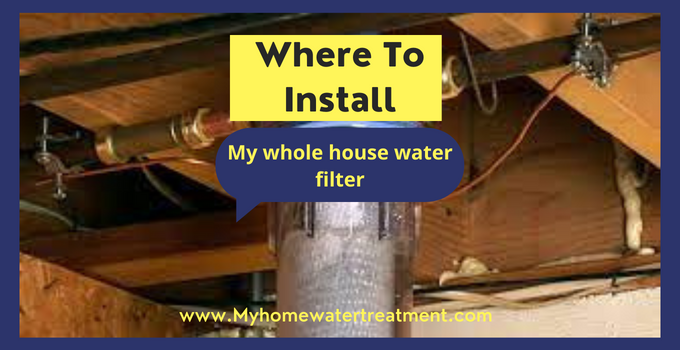Whole house water filtration systems should be installed as close to the point of entry of your water supply as possible. This is usually near your water heater, and specifically, you want it installed before the water flows into your water heater.

This is because your filter will clean the water, and make it so that your water heater doesn’t have to deal with ‘scale’ from hard water or other assorted sediments and funky things from your water supply. This will make your water heater (and anything else in the chain that you have installed post-water-filter) last longer.
Before you determine the exact spot Where To Install the filtering system, you need to figure out whether you’re getting water from a well water supply or a municipal source. This can sometimes affect the order of your system.
Well Water Installation
Usually, if you have a well-water system, the ‘chain’ in your system runs like this; first, you have your well pump. Then you have some sort of pressure tank setup. Now comes the sort of ‘wrinkle’ in the game; a lot of manufacturers advise that you install your whole-house water filtration system AFTER any sort of water softener, and before the water heater.
This is ostensibly to allow for full flow for the softener to backwash properly. There’s no chlorine in well water, so (again, theoretically) there’s no real need to put your filtration system before the water softener to protect it.
It’s recommended to split your pipe flow before the water softener and your filtration system to allow for an untreated line. Most people want this untreated water running to outside water spigots and/or to any sort of irrigation or sprinkler system you may have at your house.
Installation for Municipal Water Supply
Now when it comes to installing a central water filtration system to a municipal water supply, you do it in the exact opposite way. You still split the line so you can send untreated water outside to plants and sprinklers, but in this case you want to install the filter before the water softener. This is because you don’t really have any water pressure issues with municipal water sources.
Another reason is that well water usually has a different profile of ingredients than municipal water. Municipal supplies usually have chlorine in them, and sometimes have a fair amount of limestone and minerals. In this case, its best to put the filter in front of all your other gear…it basically cleans the water first in order to prolong the life of all your other equipment.
But why wouldn’t you do that with well water? Well, (ha!) in that case you’re concerned about water pressure and backwashing. If you’re worried about dirty water flowing through a lot of your gear and you have a well water setup, you can always add a small cartridge sediment filter to your chain at the very beginning.
This is actually a pretty good pro tip: simple cartridge sediment filters are fairly cheap, and also pretty easy to install. If you’re ever faced with an issue like the one outlined above, dropping a cartridge filter into your chain can solve a lot of things.
It almost goes without saying, but make sure to install the cartridge filter with the side saying ‘in’ coming from the water meter, and ‘out’ going to the water heater!
Check all connections and remember to always change your filter when recommended by your manufacturer.
Conclusion: Where To Install Your Water Filter
This is just a rough guide to give you an idea of where you might need Where To Install your filter. Make sure you refer to your user manual that comes with your filter system for specific installation instructions for your particular filter.
Read Also: 8 Best Countertop Water Filters in 2021